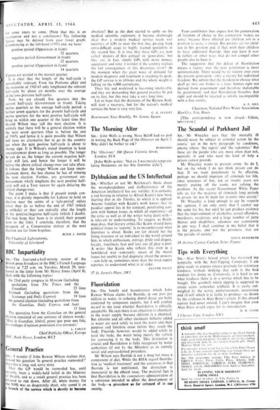Why Labour Won SIR,—It was interesting to see you grappling
with a 'scientific' solution to the problem of why Labour won the general election (SPECTATOR, April I). Un- fortunately (or fortunately for the Conservatives), you have not been scientific enough. There is a serious error in your approach which invalidates your depressing conclusion that Labour need not lose another election. If events do, in fact, prove you right, you will be hailed as a prophet, but not as an interpreter of statistics.
The defect in your argument is that you have failed to consider a long enough time period. Con- sideration of a longer period may not, of course. be possible; but the period 1955 to 1966 is certainly not a long enough one from which to make long- term predictions. The reason is that during most of the time covered the government has been the same party. Thus the statistics you quote. refer to a situation where a centre-of-the-road party has been in power and a left-of-centre party in opposition for over 90 per cent of the time-scale. It is arguable that when the full effects of a Socialist government become apparent the pattern may change, since the electorate may react against any attempt at ek tremism. In the last Labour government socialism was masked because of the small majority; and it seems certain that much of Labour's support ill the 1966 election stemmed from its appearance as a centre party. If Harold Wilson is clever enough to keep it that way, Labour may welt win the nest election; but I doubt whether he is.
However, having said that, let me assume that the correlation indicated. by your diagram will hold for some years to come. (Note that this is an assumption and not a conclusion.) The following figures may be derived from your lower graph. Commencing at the left-hand (1955) end, we have:
positive period (Opposition in front)
12 quarters.
negative period (Government in front)
12 quarters.
positive period (Opposition in front) 14 quarters.
Figures are quoted to the nearest quarter.
It is clear that the length of the half-cycle is remarkably constant. Even the Profumo affair and the recession of 1962-63 only lengthened the relevant half-cycle by about six months over the average of the two previous half-cycles.
Now, we are already five quarters into the current half-cycle (Government in front). Taking twelve quarters as the average half-cycle period, a further seven quarters for the present half-cycle and twelve quarters for the next positive half-cycle will bring us within one quarter of the latest time that Harold Wilson may call the next election. It is unlikely that there will be a general election within the next seven' quarters (that is, before the end of 1967); and hence it is quite possible that Wilson will have no alternative but to go to the country just when the next positive half-cycle is about to change sign. It is Wilson's stated intention to keep unemployment down as long as possible. The longer he can do so, the longer the current negative half- cycle will last, and hence the longer it will be before the above critical change-over can take place. It follows that the longer Wilson can keep unem- ployment down, the less chance he has of winning the next election. Further, any government em- barrassment which lengthens the next positive half- cycle will aid a Tory victory by again delaying the critical change-over.
The point I make is that if present trends con- tinue. it is plainly impossible for Labour to hold an election near the centre of a 'safe-period' unless either they do so before the end of 1967 (which is unlikely) or they can radically alter the length of the positive/negative half-cycle (which I doubt). The best hope they have is to stretch their present term to the limit. I conclude, therefore, that the prospects of a Conservative victory at the next election are far from hopeless.
PETER J. SMITH
The Chadwick Laboratories, University of Liverpool



































 Previous page
Previous page